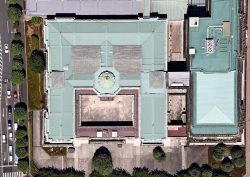13:59 JST, February 18, 2024
The H3 Launch Vehicle developed by the Japan Aerospace Exploration Agency (JAXA) and Mitsubishi Heavy Industries, Ltd. was finally launched successfully. The launch of the H3 rocket should serve as an opportunity to advance Japan’s space development, which has been stagnant.
The development of the engines for the new H3 faced difficulties. After several postponements, the first launch attempt in March 2023 ended in failure because the second stage engine failed to ignite. The launch of the second rocket this time was vindication, and all the people involved must be relieved.
Japan’s mainstay launch vehicles are entering a period of generational change. The H-2A will soon be retired and replaced by the H3, and the smaller Epsilon Launch Vehicle will be succeeded by the improved Epsilon S.
However, the H3 has stumbled from the start. Also, the Epsilon No. 6 failed to launch in 2022, and the Epsilon S has likewise had a string of troubles recently, including an engine explosion during a ground combustion test.
With the success of the H3, the critical situation in which Japan was thought to have its back to the wall can be said to be over.
The previous H3 failure stemmed from a problem with the electrical system, and JAXA narrowed down the root cause to three possibilities, including short circuits and overcurrents. Ultimately, it was unable to pinpoint just one cause and took countermeasures for all three factors.
When a rocket launch failed in the past, the government-led investigation into the causes would take so long that the next launch would be suspended for years. It is commendable that JAXA focused on resuming launches as soon as possible and managed to send up a launch vehicle less than a year after the failure.
However, the speed of rocket development is accelerating as startups in various countries are entering the space field. The success of the H3 launch was just another step for Japan, which had been lagging behind, to only get to the starting line of international competition.
The H-2A had a reputation for good performance with few launch failures, but its high price made it less competitive from a business standpoint. The cost of a launch was reduced by about half to ¥5 billion for the H3, which should be used to drive Japan’s space industry, including future satellite launches.
SpaceX, a U.S. company that boasts a leading position in the satellite launch market, has launched dozens of rockets a year in a stable manner at low prices.
Japan, too, has formulated a strategy to launch 30 launch vehicles a year by the first half of the 2030s. Of these, 20 are expected to be private-sector launch vehicles.
It is important to strengthen the development of the launch vehicle business for startups by utilizing such measures as the space strategy fund established by the government for JAXA at the scale of ¥1 trillion.
(From The Yomiuri Shimbun, Feb. 18, 2024)
"Editorial & Columns" POPULAR ARTICLE
-

Violations of Subcontract Law: Major Automakers Must Eliminate Old Practices
-

Local Governments’ Tax Revenues: Devise Ways to Correct Imbalances in Tax Sources
-

Heavy Rains in Asia: Support for Victims, Flood-Control Measures Urgently Needed
-

5 Japanese Business Dinner Mistakes to Avoid — and What They Taught Me About Business in Japan
-

New Nuclear Threat: China Seeking to Follow U.S., Russia in Military Expansion
JN ACCESS RANKING
-

Keidanren Chairman Yoshinobu Tsutsui Visits Kashiwazaki-Kariwa Nuclear Power Plant; Inspects New Emergency Safety System
-

Imports of Rare Earths from China Facing Delays, May Be Caused by Deterioration of Japan-China Relations
-

University of Tokyo Professor Discusses Japanese Economic Security in Interview Ahead of Forum
-

Japan Pulls out of Vietnam Nuclear Project, Complicating Hanoi’s Power Plans
-

Govt Aims to Expand NISA Program Lineup, Abolish Age Restriction




















